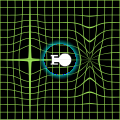Warp drive
Warp drive (also called warp technology) is a hypothetical technology created in science fiction.[1] As far as we know, it does nor exist. Its invention allowed writing books and making television and film media.[2]
If it takes centuries or thousands of years to get anywhere in space, then the limitations of human life becomes an obstacle. That's even assuming we could travel without humans being riddled with holes by radiation of various kinds. We are so protected on planet Earth that we forget what it's like in deep space, which is flooded with radiation.
So warp drive is invented, and so is its cousin wormholes in space. There are no wormholes, or if they exist, we don't know it.
Warp drive and wormholes are the inventions of smart guys who make media. It is a way of moving objects faster than the speed of light. There are many examples of how this idea is used. A well-known one is found in the Star Trek universe, where faster-than-light travel is needed to tell the story.
Current technology does not allow anything or anyone to go at, or faster than, the speed of light. Unless the current theories are proven wrong, this will always be true. However, warp technology as a fictional idea has been an interesting way of shaping the story line to let spaceships move at speeds greater than 186,000 miles per second (speed of light through a vacuum: the known limit of speed in the universe).
Warp technology, as the name implies, 'warps space' in effect bringing a destination closer by bending space rather than the traditional 'thruster' means of propelling a spacecraft at high speeds.
Warp technology allows ships to move at warp speed. In the Star Trek universe, for example, the measurement of the speed that the spaceship is moving is called the warp factor. However, thrusters and impulse power propel spaceships at sub-light speed. Warp factor 1 is equal to the speed of light. The speed ranges up to warp factor 9.99. In some circumstances Star Trek spaceships can go faster than warp 10, although rarely.
Most of that is pure science fiction, and no evidence has been produced of any "warp drive".
In the field of quantum mechanics physicists have produced tiny wormholes, but they don't warp space time in the same way the "warp drive" concept does, rather they connect two separate points of spacetime through quantum entanglement.
Warp Drive Media
Lorentz factor γ as a function of velocity. Its initial value is 1 (when v = 0); and as velocity approaches the speed of light (v → c) γ increases without bound (γ → ∞).
References
+{{{1}}}−{{{2}}}


